Physical Address
304 North Cardinal St.
Dorchester Center, MA 02124
Ankle fractures are a commonly encountered injury to the lower extremity and account for approximately 9% of all fractures. The incidence of ankle fractures has been increasing among all age groups, and the mechanism of injury is most commonly a fall (35.68%), sports injury (35.26%), exercise injury (19.29%), jumping (5.38%), or a generalized trauma (4.06%). Most ankle fracture patients can be provisionally treated in the emergency department and discharged (82%); however, up to 16% of patients may need to be admitted for further workup and care. The appropriate treatment choice for certain ankle fractures is often up to the surgeon’s discretion and controversy persists regarding optimal treatment and surgical technique for some fracture patterns. However, with careful patient evaluation, attention to detail, and adequate fixation, outcomes can be optimized.
The ankle is a modified hinge joint with coupled rotations occurring in both the axial and coronal planes. The ankle joint consists of three bones (tibia, fibula, and talus) and their connecting ligaments (deltoid, lateral ligament complex, and syndesmosis) ( Fig. 44-1 ). The interaction of the joint surfaces of these bones is quite intricate.
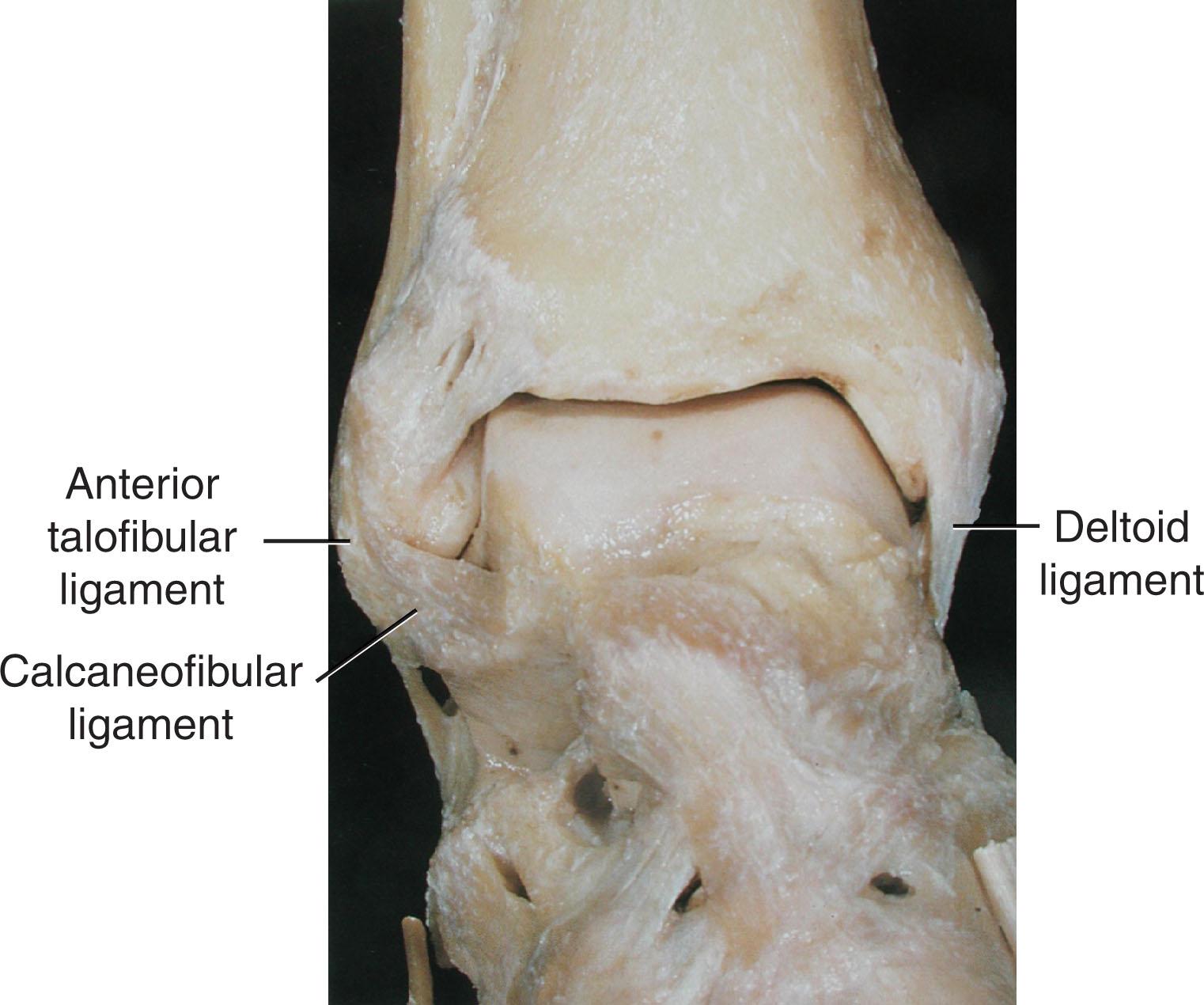
The articular surface at the distal aspect of the tibia is called the tibial plafond. It is broader anteriorly than posteriorly and is longer laterally than medially. It is concave both from anterior to posterior and medial to lateral. The most distal extension of the tibia is the medial malleolus which is divided into two parts, the anterior and posterior colliculus.
The terminal extension of the distal fibula is the lateral malleolus. It has a broad medial articular surface that articulates with the lateral side of the talus. The lateral malleolus extends approximately 1 cm distal and posterior to the medial malleolus.
The talus articulates with the tibia proximally and the calcaneus distally, the navicular medially, and the fibula laterally. The dorsum of the talus mirrors the configuration of the tibial plafond, but it has two shallow crests rather than the single round dome that might be interpreted on radiographs. It also is wider anteriorly than posteriorly. The medial talar articular surface is curvilinear and comma shaped in its articulation with the medial malleolus. The talar articulation with the lateral malleolus is more triangular in its configuration.
These various articulations are held together by strong ligamentous support. The deltoid ligament provides medial support and is divided into two portions: superficial and deep ( Fig. 44-2 ). The superficial portion extends from the tip of the medial malleolus and inserts broadly onto the navicular, sustentaculum tali (calcaneus), and the talus. The deep deltoid portion is a strong condensation of capsular fibers extending from the intercollicular notch of the medial malleolus to the medial talus. Functionally, the superficial deltoid resists hindfoot eversion, and the deep portion prevents external rotation of the talus. The deep portion also is the primary soft tissue restraint to medial opening.
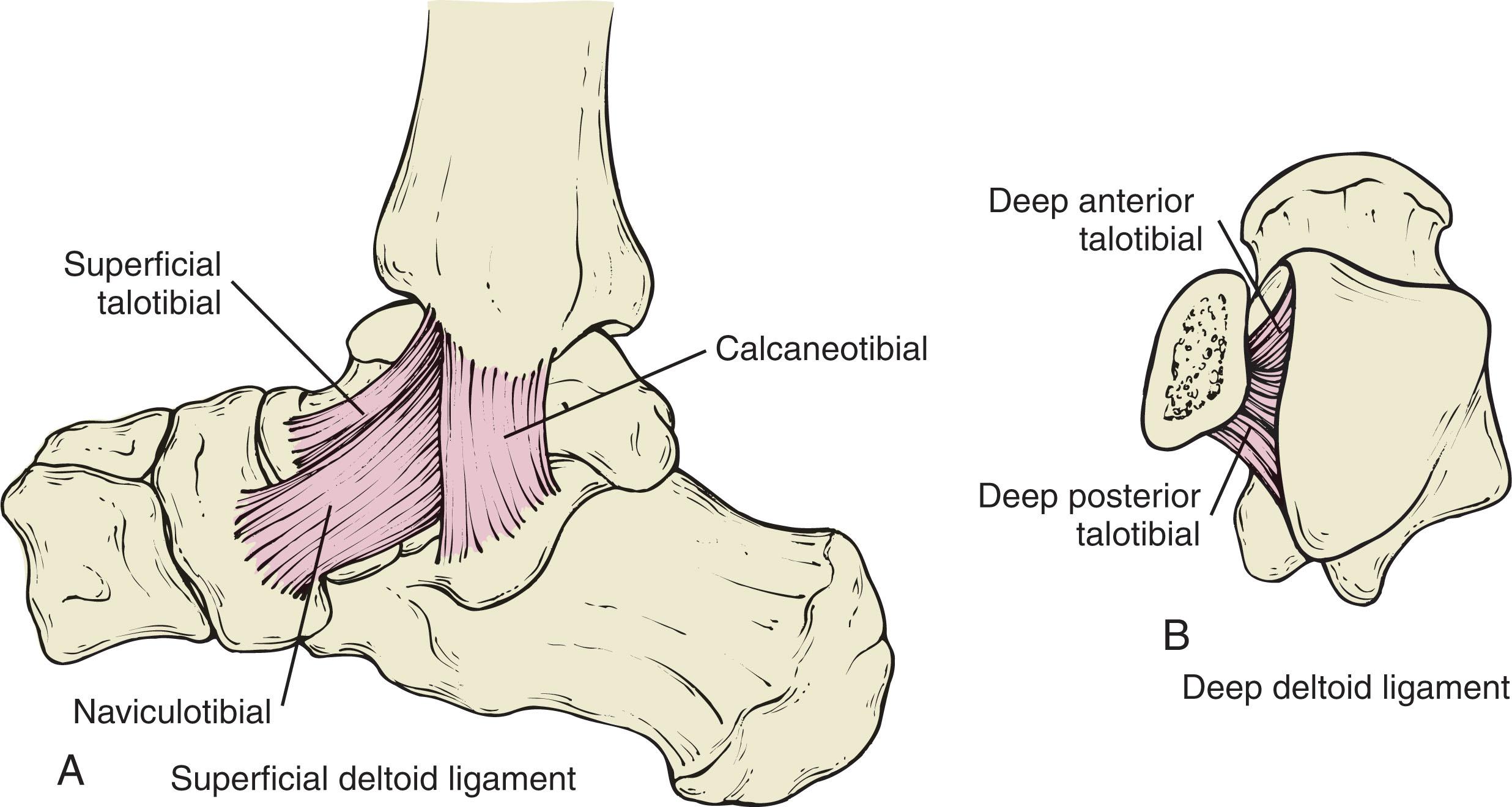
The lateral ligament complex is made up of three discrete components: the anterior talofibular ligament (ATFL), calcaneofibular ligament (CFL), and the posterior talofibular ligament (PTFL) ( Fig. 44-3 ). These ligaments are not as robust as their medial counterparts. The ATFL is a primary restraint to anterior displacement, internal rotation, and inversion of the talus. It is also the most frequently injured. The CFL is deep to the peroneal tendons and runs from the distal fibula to the posterior lateral tubercle of the calcaneus. It helps to stabilize the subtalar joint and is most susceptible to injury in extremes of inversion. The PTFL runs from the posterior aspect of the fibula to the posterior aspect of the talus ( Fig. 44-4 ).
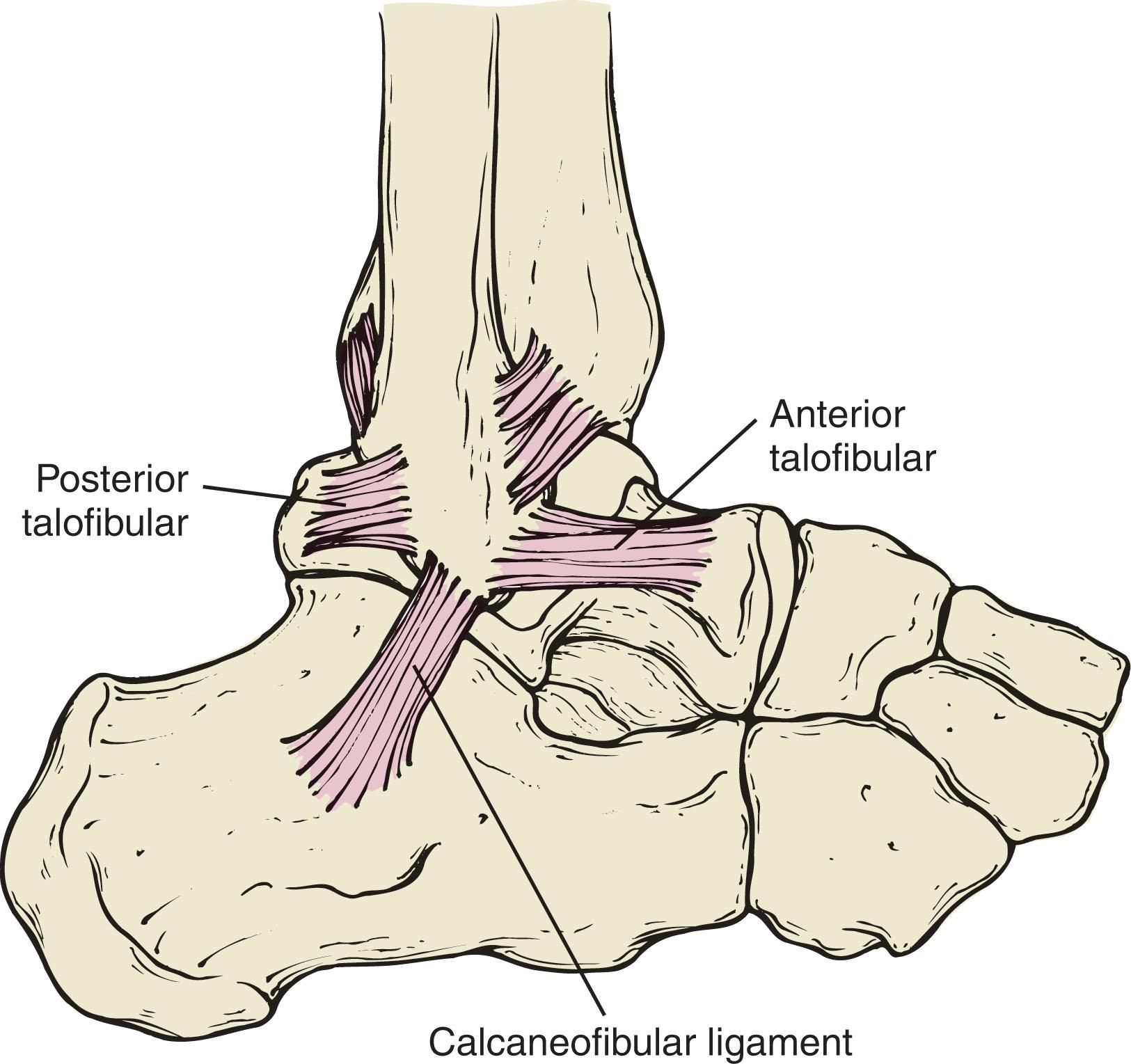
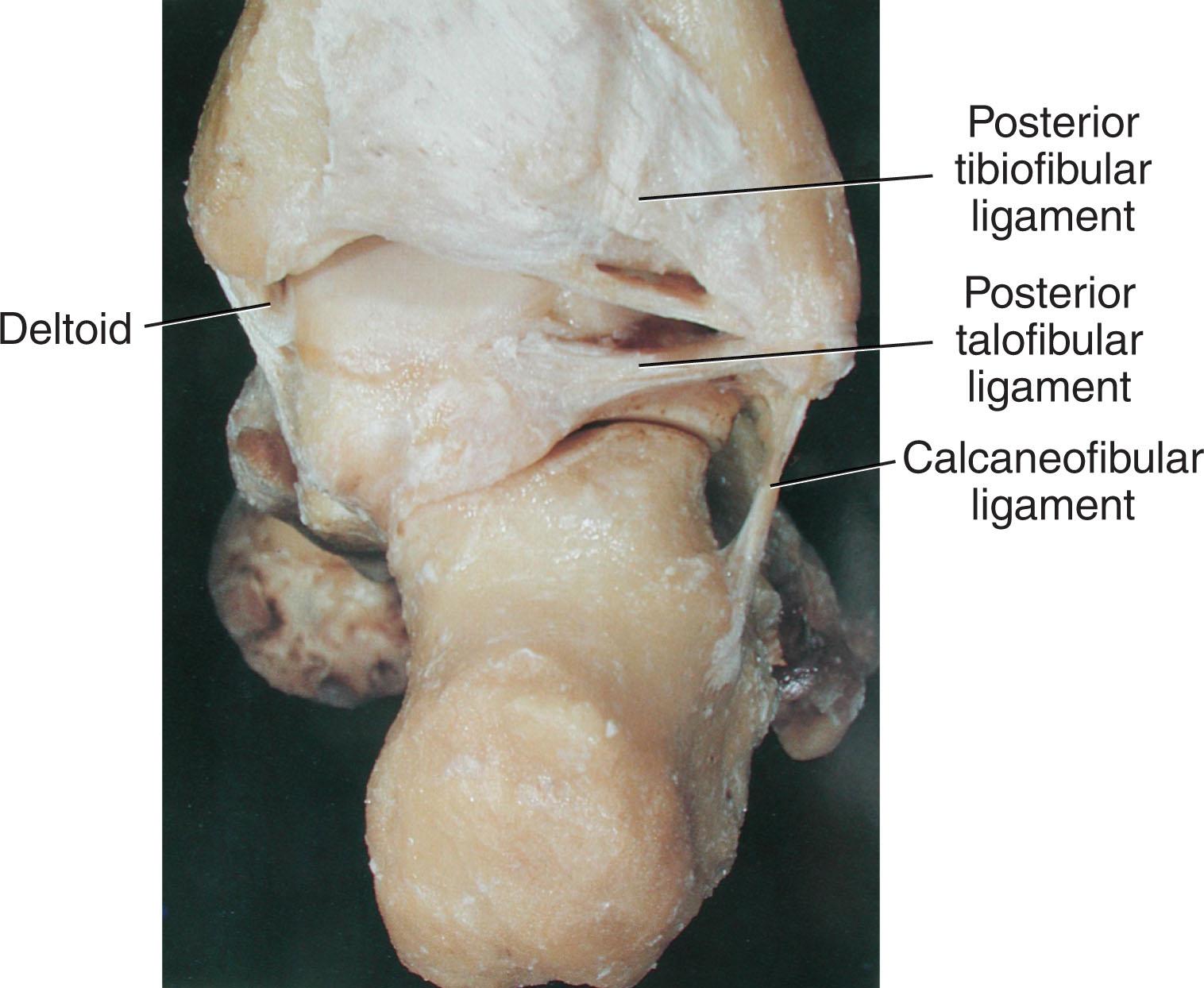
The syndesmosis holds the distal ends of the tibia and fibula together. It is made up of four ligaments and the interosseous membrane ( Figs. 44-5 and 44-6 ). Anteriorly is the anteroinferior tibiofibular ligament (AITFL), which runs from the lateral surface of the tibia to the fibula and is quadrilateral. This ligament can be avulsed with its tibial attachment at the tubercle of Chaput, resulting in a Chaput fracture. Biomechanical testing has shown that sectioning of the AITFL leads to an approximately 24% reduction in resistance to external rotation. Posteriorly, in a corresponding position between the tibia and fibula, is the smaller posteroinferior tibiofibular ligament (PITFL). Nearly contiguous with the posteroinferior tibiofibular ligament is the inferior transverse ligament running from the posterior articular margin of the tibia to the fibula. These ligaments can avulse various-sized portions of the posterior malleolus of the tibia. The eponymous fracture fragment of the PITFL is the Volkmann fragment. The interosseous ligament runs obliquely downward from the tibia toward the fibula and is the distal condensation of the interosseous membrane between the tibia and fibula.
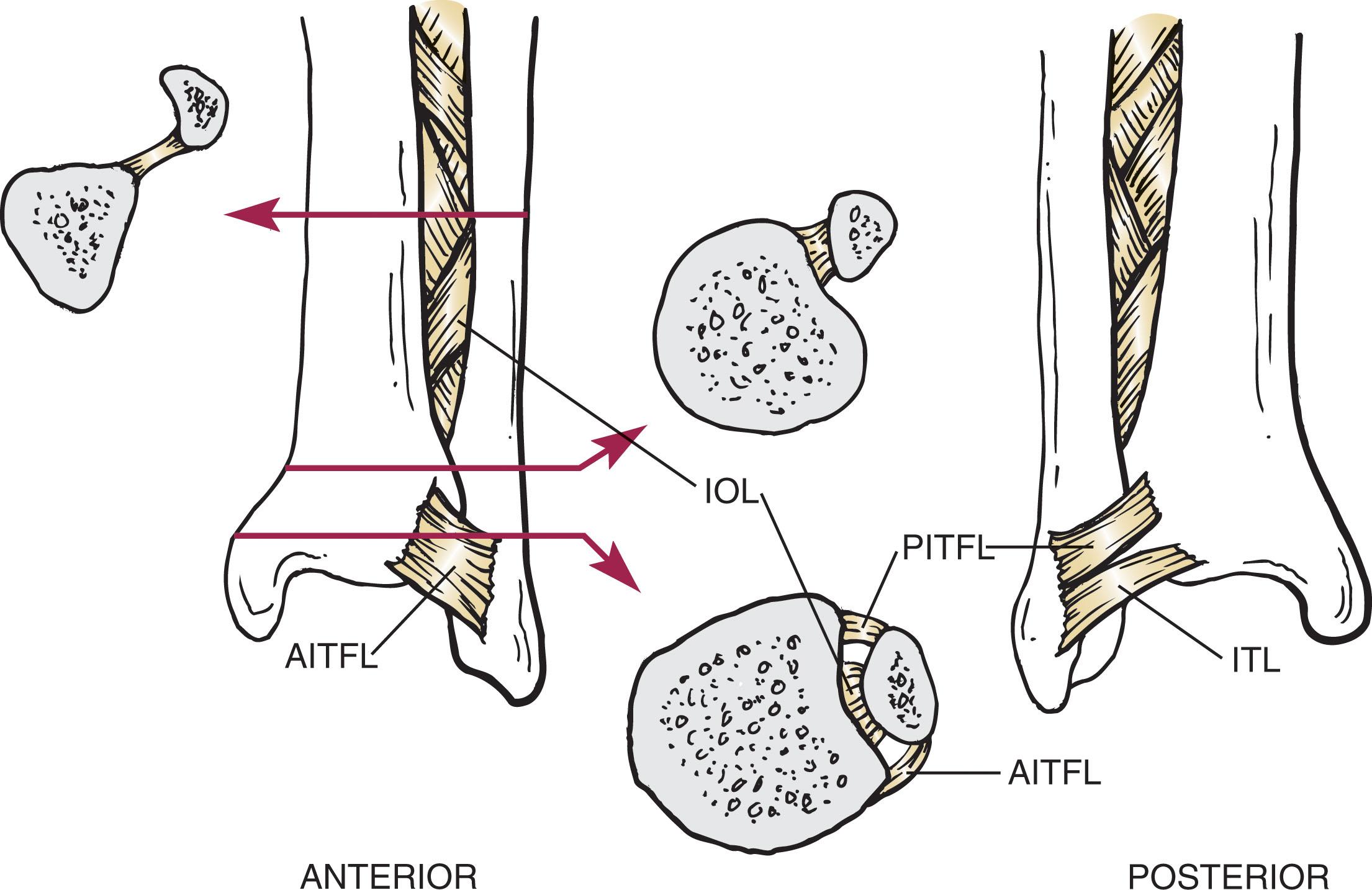
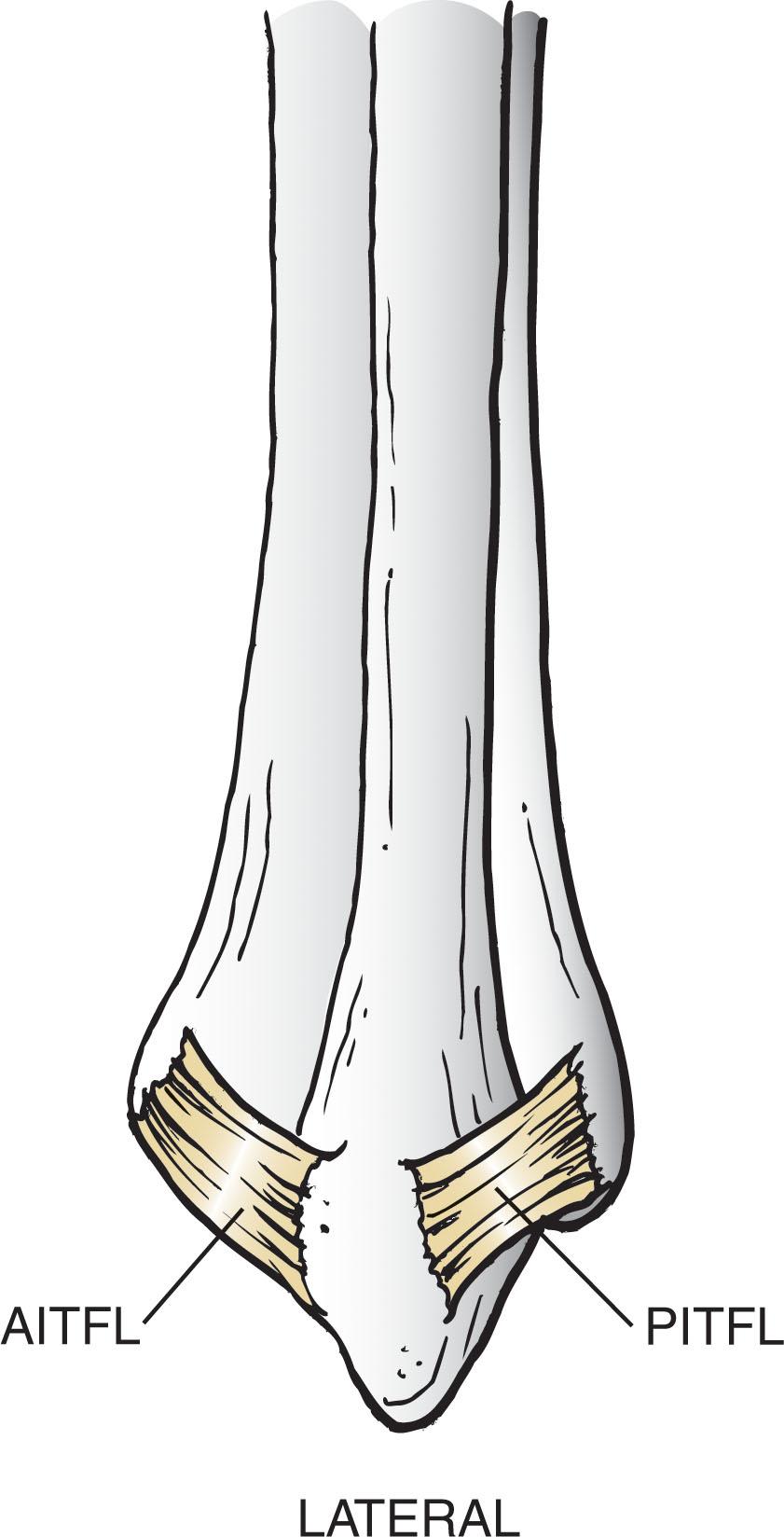
The geometry of the bones and the syndesmosis allows motion between the tibia and fibula. In addition to moving medially and laterally, the fibula also moves up and down as well as rotationally. Fractures, ligament injuries, and combinations of the two can disrupt the precise alignment of the ankle joint, resulting in altered tibiotalar contact stresses and ligamentous instability.
The skin overlying the ankle is relatively thin and, compared to other parts of the body, the blood supply is relatively poor. This blood supply is derived from contributions of the anterior tibial, posterior tibial, and peroneal arteries. Each artery has a defined angiosome as shown in Fig. 44-7 . These angiosomes guide operative approaches to the ankle and are important to consider when identifying potential solutions to wound coverage issues.
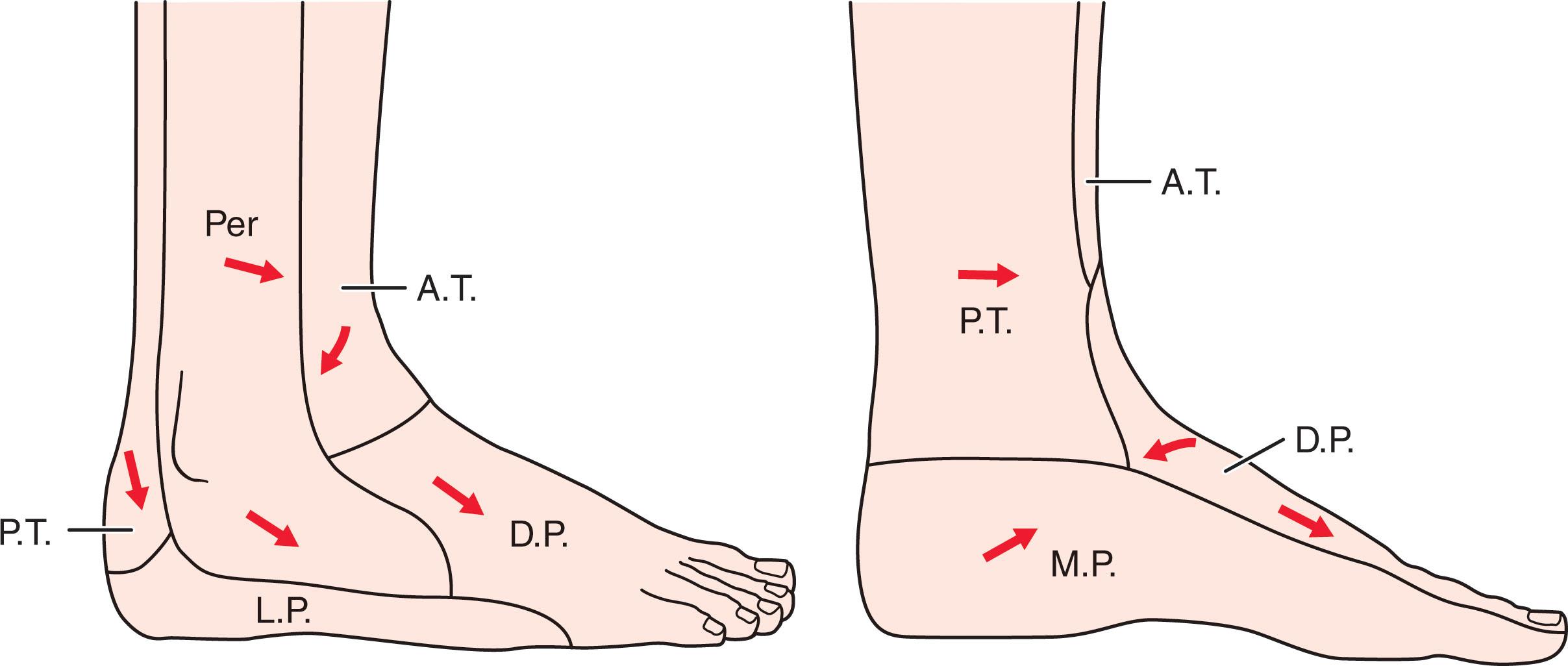
Numerous classification systems for ankle fractures exist in the literature. Historically, the Lauge-Hansen, Danis-Weber, and AO classification systems have been the most frequently utilized and cited. The Lauge-Hansen classification system describes the position of the foot at the time of injury and the vector of the deforming force. This system can accurately classify approximately 60% of all ankle fractures. The stages of the Lauge-Hansen classification are demonstrated in Fig. 44-8 .
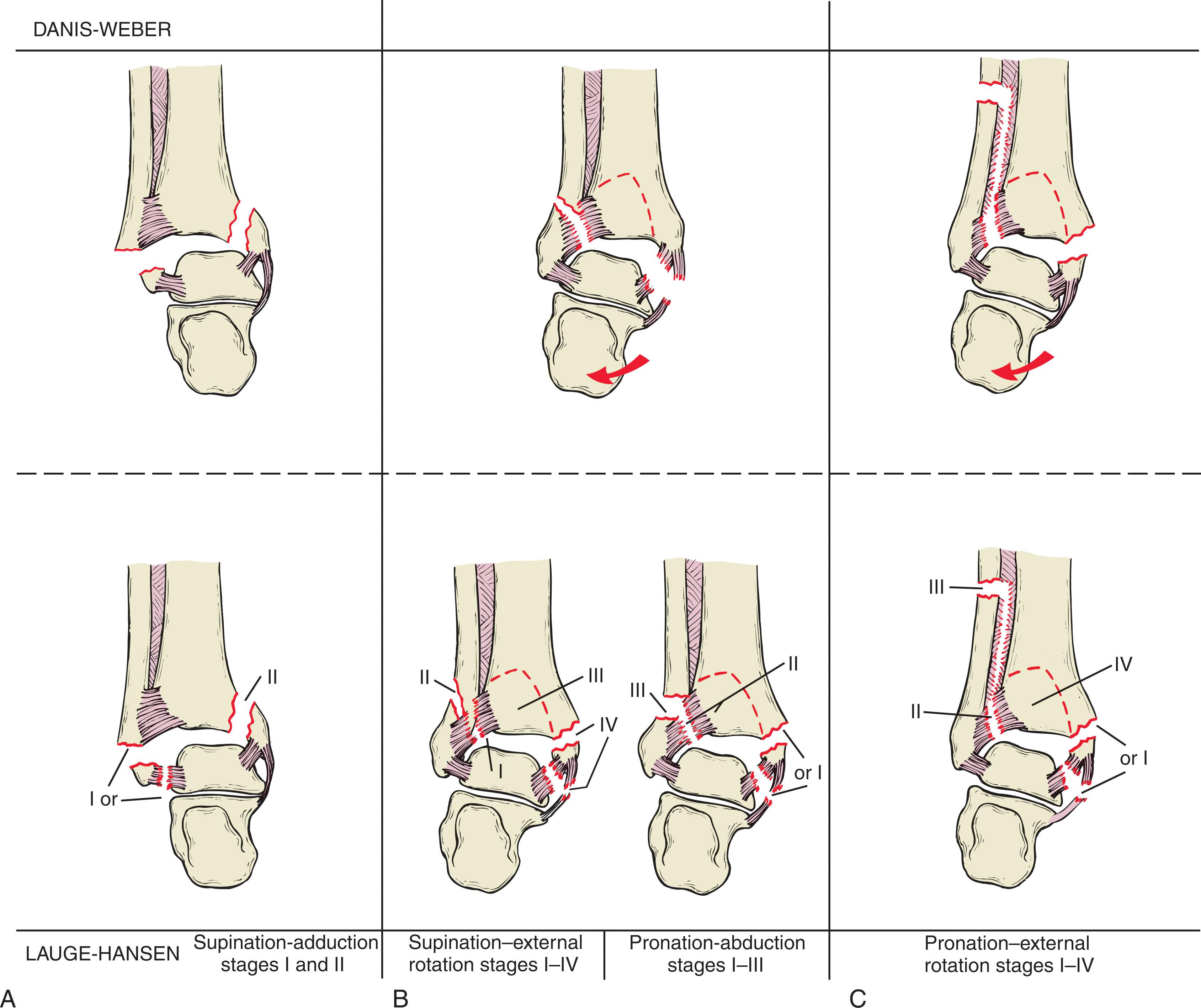
While the Lauge-Hansen system has its potential benefits, the interrater reliability is poor. A recent cadaveric study has also demonstrated that the pattern of ankle fracture seen may be influenced more by the vector of the deforming force rather than the foot position at time of injury. In this study, a simulated injury with primarily external rotation forces produced a distal oblique fibula fracture, and with combined external rotation-abduction forces, a more proximal, sometimes comminuted fibula fracture was produced. In simulated external rotation injuries, the lateral injury occurred first, while in simulated external rotation-abduction injuries, the medial injury occurred first. The Lauge-Hansen classification remains useful to convey fracture morphology amongst clinicians; however, its intended description of the mechanism of injury may not illustrate the exact biomechanics of an ankle fracture.
The Danis-Weber system is based on the level of the fibula fracture and is divided into three types. This system is simpler than the Lauge-Hansen classification and has a higher interrater reliability. Weber A fibula fractures occur below the level of the syndesmosis, Weber B fractures occur at the level of the syndesmosis, and Weber C fractures occur above the level of the syndesmosis (see Fig. 44-8 ). The AO/OTA classification uses the Danis-Weber system as a guideline to describe the current AO Müller classification with the addition of medial modifiers. Fig. 44-9 demonstrates the stages of the AO/OTA classification.
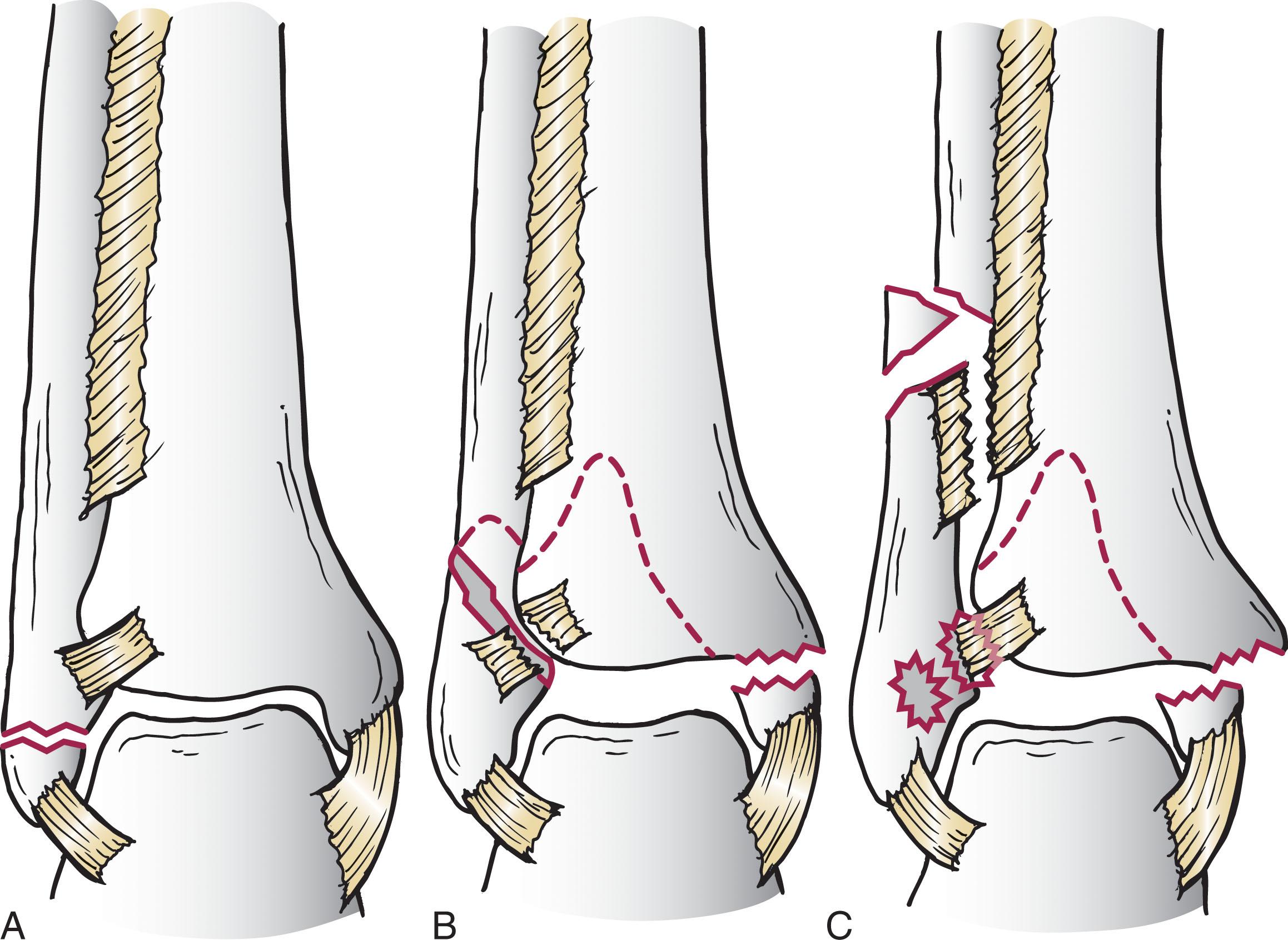
Radiographs of the ankle provide useful information regarding the mechanism of injury, the severity of the injury, the optimal approach to the injury, and the potential expected results of treatment, both surgical and nonsurgical.
Anteroposterior (AP), lateral, and mortise (an oblique view with the foot internally rotated 15–20 degrees) views are standard and allow for evaluation of the integrity of the ankle mortise and of the tibiofibular syndesmosis. Criteria for displacement continue to evolve, but radiographic evaluation of the uninvolved extremity can serve as a valuable comparison for cases of subtle displacement or instability. Radiographs should be evaluated for documented reduction criteria ( Fig. 44-10 ). Of utmost significance is the medial clear space. Widening indicates talar translation or external rotation and loss of the integrity of the ankle mortise ( Fig. 44-11 ). Continued displacement of the medial clear space greater than 4 mm or narrower than 1 mm is associated with a poor long-term outcome. Talar shift of as little as 1 mm can result in a 42% reduction in talotibial contact area.

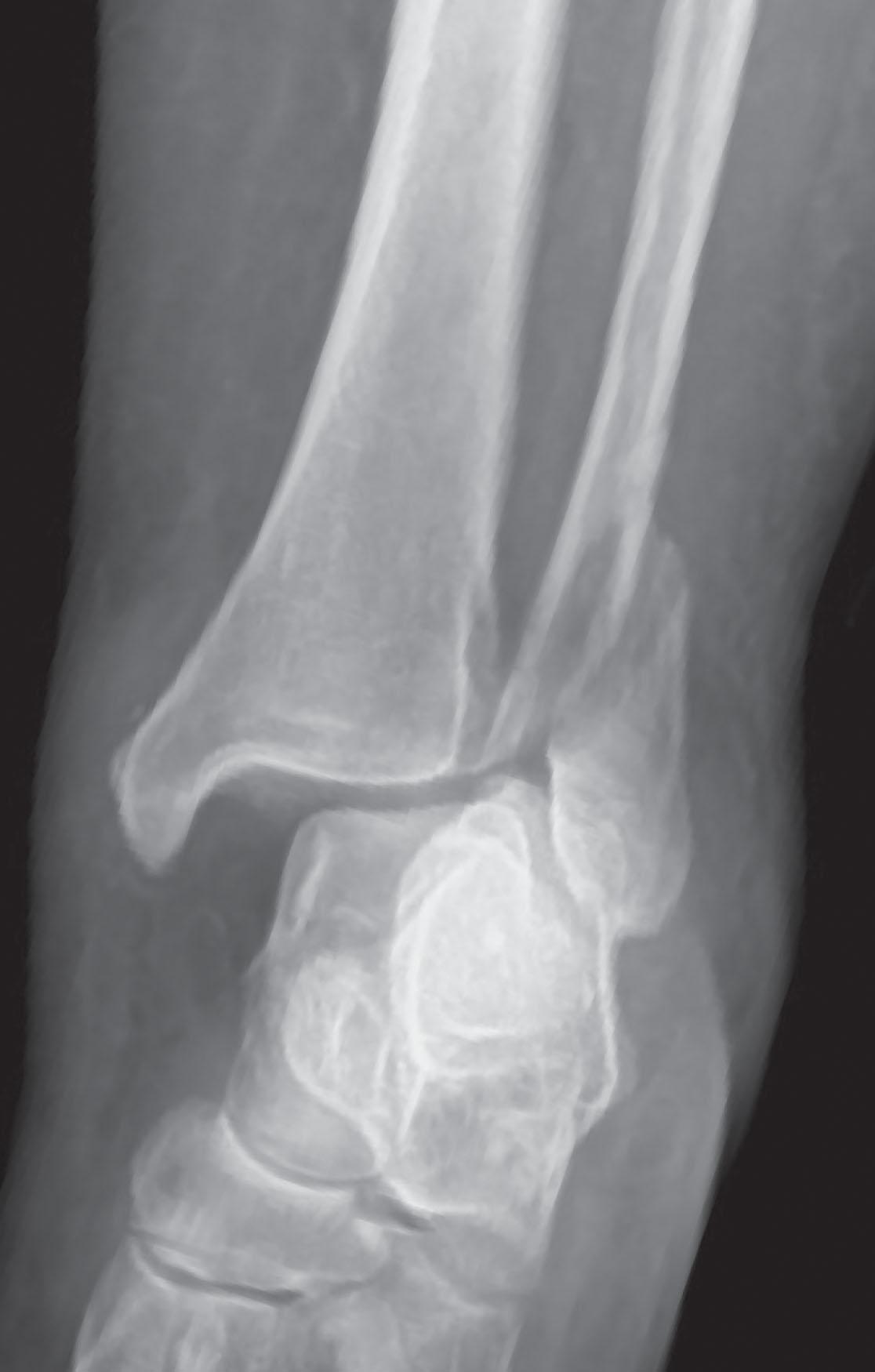
The integrity of the syndesmosis is best assessed on the AP projection. Direct measurement of the syndesmosis width is taken 1 cm above the joint surface of the talus and is defined as the horizontal distance from the tibial incisura to the medial border of the fibula ( Fig. 44-12 ). However, even a complete syndesmotic injury, if nondisplaced, can appear normal on static radiographs. The tibiofibular clear space (from the lateral border of the posterior tibial malleolus to the medial border of the fibula) might not change as the fibula rotates outward. This distance should be less than 5 mm. It is necessary to evaluate the extent of overlap of the fibula by the anterior tibial tubercle. The tibiofibular overlap from the medial border of the fibula to the lateral border of the anterior tibial prominence should be less than 10 mm. The medial clear space can be widened due to laxity of the syndesmosis, which also can produce abnormal talar tilt. Despite continuity of the deltoid ligament, the medial clear space can increase up to 2 to 3 mm. Comparison views, gravity stress, or external rotation stress views of the ankle are often indicated to determine stability.
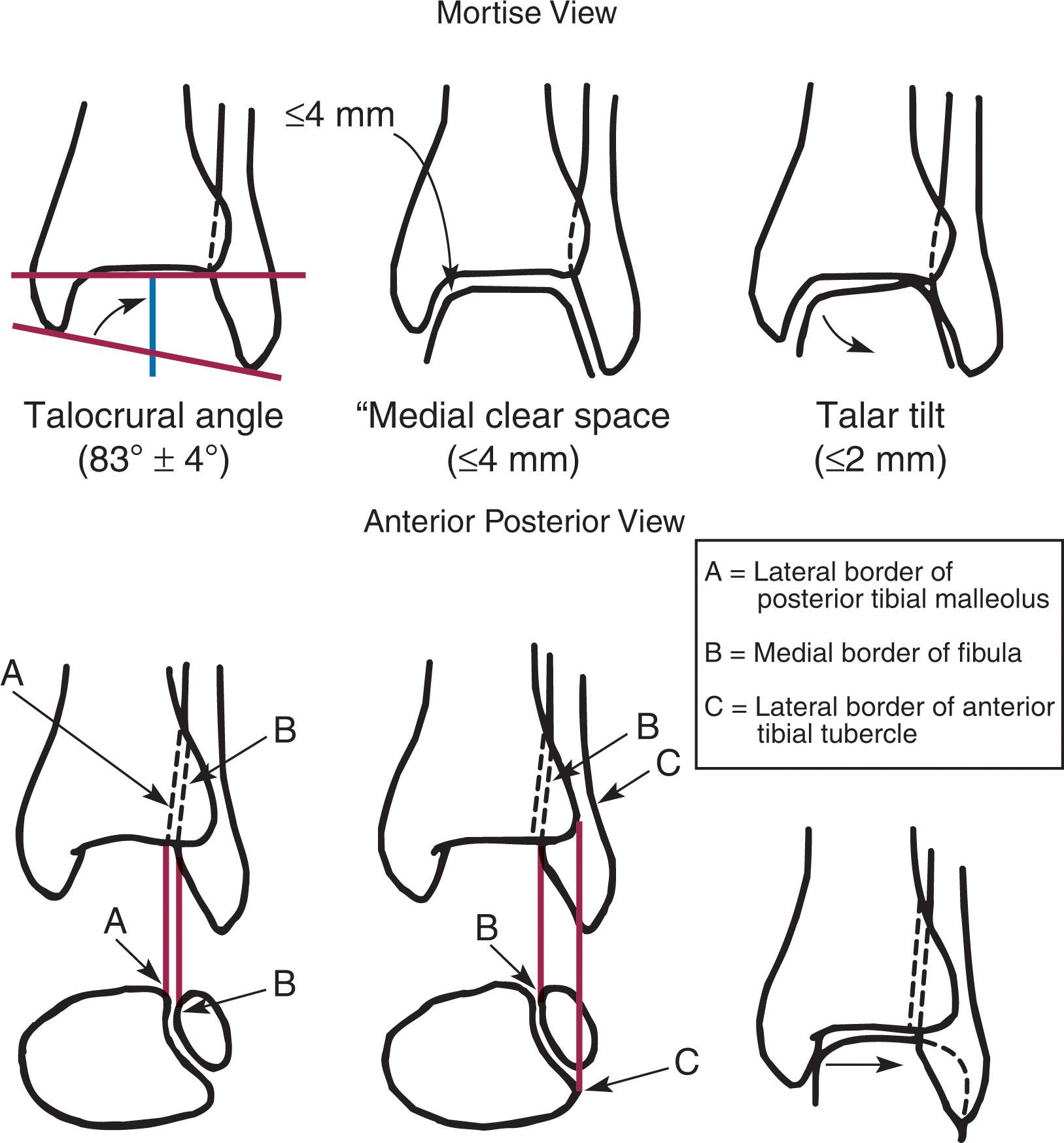
On the mortise view, the ankle articular spaces should appear symmetric. The superior surface of the talus should be congruent with the tibial plafond, and the medial and lateral articular spaces should be equal and comparable to the superior surface. The subchondral bone that forms the Shenton line should be intact. There should also be a continuous curve between the lateral talus and the recessed tip of the distal fibula ( Fig. 44-13 ). Disruption of this line and circle is usually the result of shortening and external rotation of the fibula ( Fig. 44-14 ).

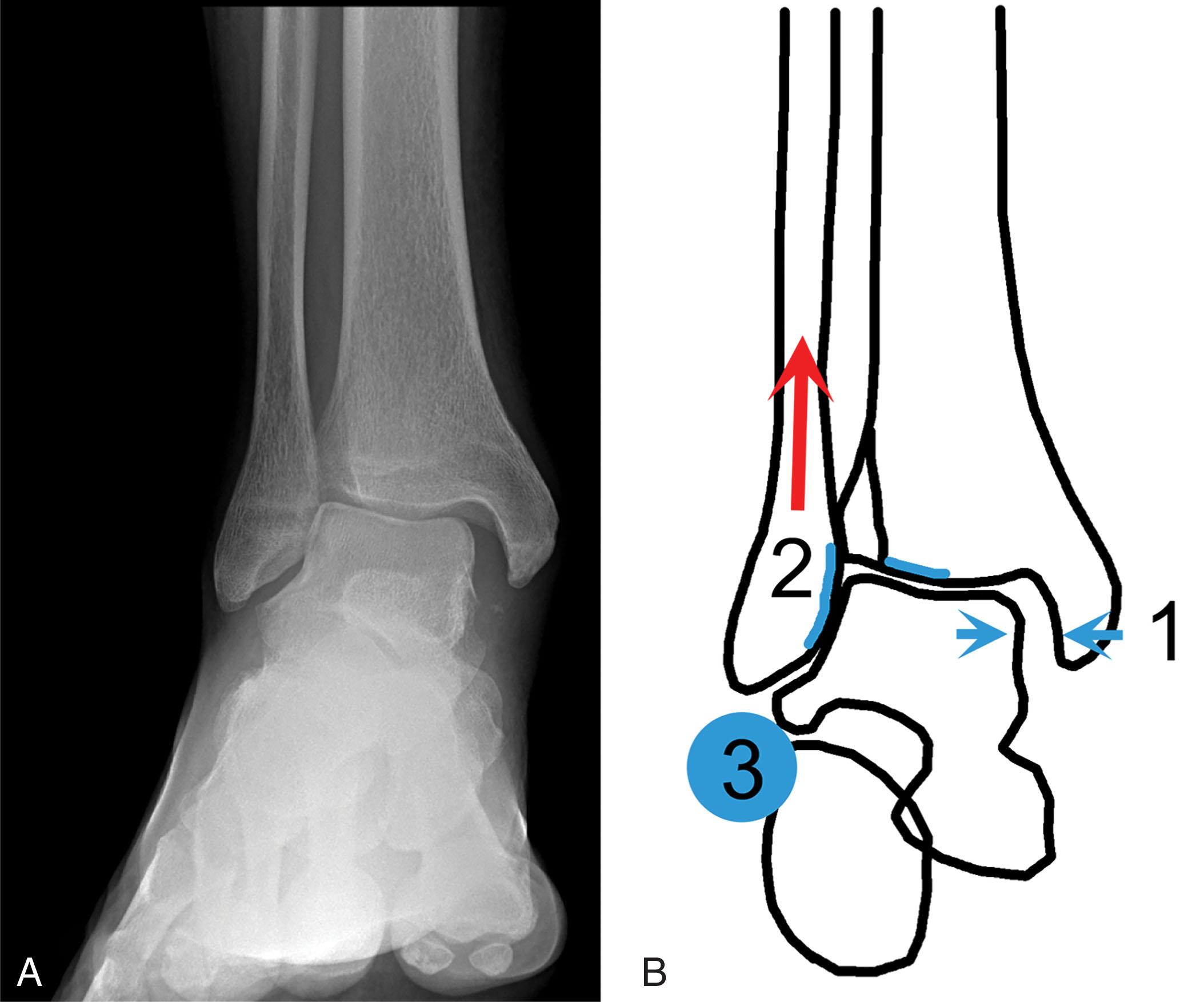
An additional measurement is that of the talocrural angle. This is formed by a line perpendicular to the distal tibia articular surface and a line connecting the ends of the medial and lateral malleoli (see Figs. 44-10 and 44-12 ). This angle averages 83 ± 4 degrees, and there should be less than 2 degrees of variance from the contralateral ankle. A shallow angle suggests fibular shortening.
Another useful marker for ankle alignment is talar tilt (see Figs. 44-10 and 44-12 ). A line is drawn across the talar dome in the AP view, and a second line is drawn perpendicular to it. A third line is drawn down the weight-bearing center of the tibia and through the angle formed by the intersection of the first two lines. More than 5 degrees of difference from the contralateral ankle is abnormal. On the mortise view, the talar tilt can be calculated by drawing a line across the tibial plafond and another across the top of the talus. A distance of more than 2 mm between these lines indicates that instability may be present.
In addition to the standard radiographic views, a full-length view of the tibia and fibula may be needed to identify injuries resulting in a proximal fibula fracture, a pattern of injury often referred to as a Maisonneuve fracture. Three views of the foot are also typically obtained given the high frequency of concomitant injuries.
The use of computed tomography (CT) imaging prior to operative intervention for ankle fractures has been increasing. Several studies have demonstrated that the size of the posterior malleolus fragment cannot accurately be determined based on plain radiographs and underscore the benefit of CT imaging. One study found that CT imaging may change the original operative plan and positioning in up to 44% of cases.
Indications for CT scan include a large (>10% of the articular surface as measured on a lateral radiograph) or a comminuted posterior malleolus fracture, a comminuted medial malleolus fracture, impaction of the tibial plafond, or visualized loose bodies. The syndesmosis can also be evaluated on CT and may influence the decision to pursue operative versus nonoperative treatment in cases of subtle instability.
The best possible functional results in the treatment of ankle fractures and fracture dislocations are obtained when the joint surfaces are reduced anatomically, the reduction is maintained throughout the treatment, and the joint is mobilized as soon as possible without disturbing the reduction. In general, dislocations and fractures should be reduced as soon as possible. Fractures are generally easier to reduce closer to the time of injury, before swelling and hematoma formation occurs. Early reduction also minimizes the risk of circulatory impairment, skin necrosis, and neuropraxia associated with gross displacement in these injuries. Precise reconstitution of all joint surfaces should be a priority because nonanatomic reduction can lead to joint instability and joint surface incongruity that can predispose to arthritic changes. Once an anatomic reduction has been achieved, it must be maintained until the bone and ligament structures have healed sufficiently to provide stability.
Prolonged immobilization results in multiple undesirable sequelae including muscle atrophy, myostatic contracture, decreased joint motion, proliferation of the connective tissues in the capsular structures, internal synovial adhesions, cartilaginous degeneration, and bone atrophy. Mobilization that is instituted as early as possible may help decrease the onset of these abnormal processes.
The decision to pursue operative versus nonoperative treatment for ankle fractures is dependent upon a wide range of factors. Initial management in all cases should include assessment of neurovascular status, provisional reduction and immobilization of any dislocation, and appropriate administration of antibiotics in the case of open fractures. Radiographic studies including AP, mortise, and lateral views of the ankle and AP, oblique, and lateral views of the foot should be obtained. The goal of operative intervention is to restore and stabilize the relationship between the fibula, tibia, and talus and minimize long-term complications of posttraumatic arthritis and instability.
Up to one third of ankle fractures with dislocation present as an open fracture. Open fractures are an absolute indication for operative intervention unless extenuating patient circumstances do not allow for safe operative intervention. In this case, the wound should be irrigated and cleaned/dressed at bedside and antibiotics continued until operative intervention is possible. Temporary external fixation may be indicated if the soft tissues are not amenable to definitive fixation. In most cases, early definitive fixation is typically safe as long as wound coverage can be obtained.
External fixation for closed fractures can be performed in the emergency department or operating room. In the emergency department under local anesthetic and light sedation, reduction can be obtained using uniplanar traction and external fixation pins in the proximal tibia and calcaneus under mini C-arm fluoroscopic guidance. This provides temporary reduction of the articular surface and allows soft tissue swelling and blisters to improve prior to definitive fixation while avoiding a trip to the operating room.
When deciding whether or not to accept any displacement in an ankle fracture, it is important to take into account the effects of even small displacement on ankle congruity. Yablon et al showed that the talus follows the displaced lateral malleolus. Ramsey and Hamilton postulated that a 1-mm lateral shift of the talus in the mortise reduces the contact area of the ankle by 42%. Hartford et al demonstrated that there is a significant loss of tibiotalar contact with posterior malleolar fractures involving greater than 33% of the joint surface. Fitzpatrick et al, in a cadaver study with four fracture simulations, found no increased contact stresses near the articular incongruity but found that the remaining joint bore increased stress and that the center of stress shifts anteriorly, loading cartilage that normally sees little load.
The types of fractures that are often stable enough for nonoperative treatment are isolated infrasyndesmotic (type A) fractures of the distal fibula that do not involve the medial or posterior malleolus and isolated nondisplaced transsyndesmotic (type B) fractures of the lateral malleolus that do not demonstrate syndesmotic or medial clear space widening.
Displaced distal fibula fractures without posterior or medial malleolar involvement are the most controversial fractures in regard to appropriate treatment measures. Traditionally, medial clear space widening greater than 4 to 5 mm has been deemed to represent an unstable ankle fracture and an indication for operative intervention. However, static non–weight-bearing radiographs do not capture the dynamic nature of the tibiotalar relationship. Often, stress views or weight-bearing radiographs are necessary to determine ankle stability.
Gravity stress examination is performed by placing the patient in the lateral decubitus position on the injured side. The injured ankle is positioned off the end of the table in a dependent position and a standard ankle mortise radiograph performed in 10 degrees of internal rotation. Manual stress examination is performed by placing the patient in the supine position with tibia internally rotated 10 degrees. Next, an external rotation force is applied to the foot while the tibia is held steady with the ankle in neutral dorsiflexion. A mortise ankle radiograph is then obtained ( Fig. 44-15 ). Gill et al demonstrated that gravity stress examination is equivalent to manual stress examination for the determination of ankle stability. However, manual stress examination has been shown to increase visual analog scale (VAS) pain scores compared to gravity stress examination, 6.1 versus 3.5, respectively ( P <0.05). Weight-bearing stress examination is performed by instructing the patient to place full weight equally on both lower extremities and a mortise radiograph is obtained. Weight-bearing radiographs have been shown to reliably determine ankle stability, as well. Once stress examination has been performed, whether gravity, manual, or weight bearing, the medial clear space is then evaluated for widening. Medial clear space is measured as the distance from the medial border of the talus to the lateral border of the medial malleolus, on a line perpendicular to the medial articular surface.
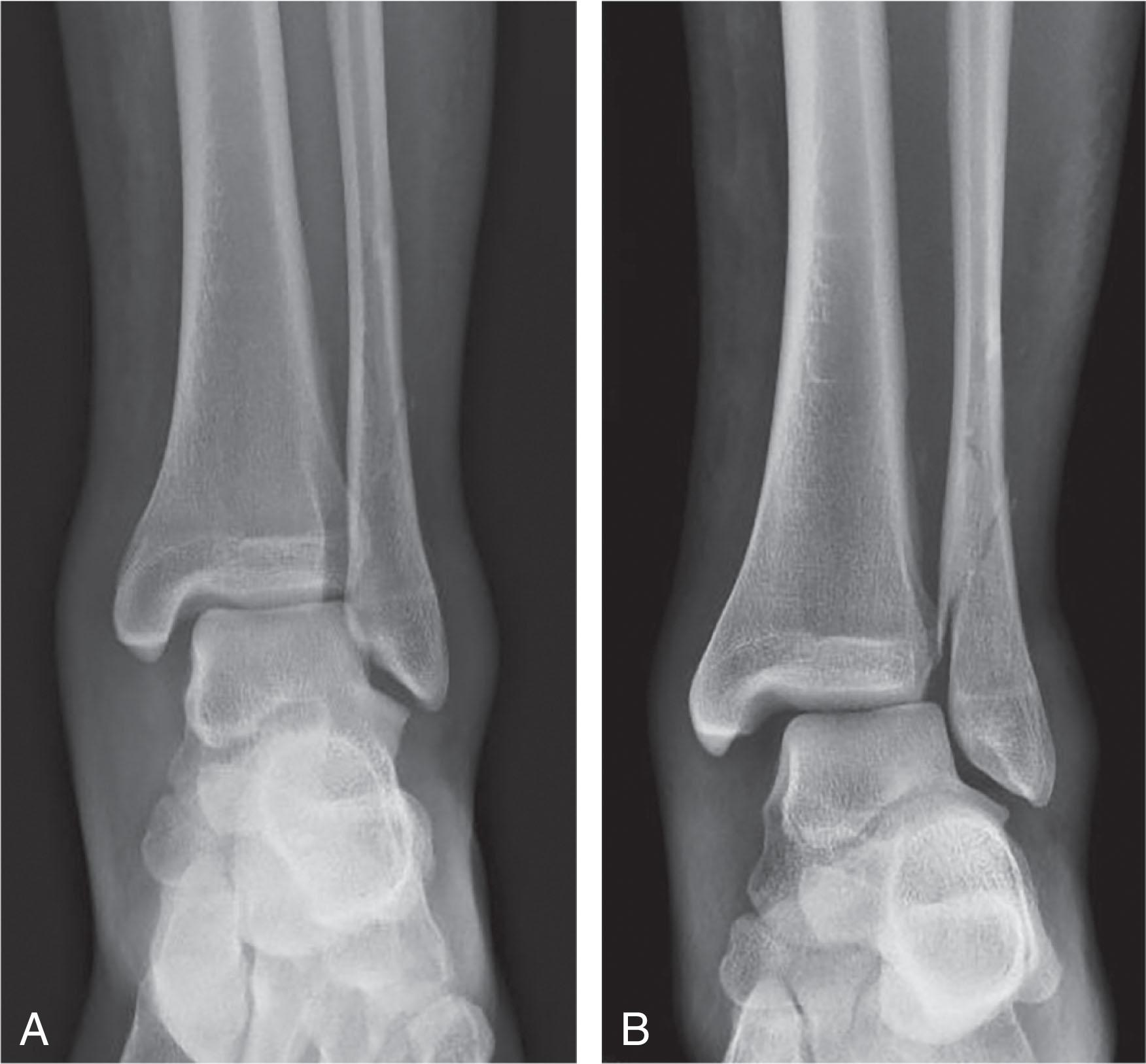
Holmes et al performed a retrospective review of 51 patients with Weber B ankle fractures successfully treated nonoperatively. Their evaluation for nonoperative treatment included gravity stress examination of bilateral ankles, as described above. Ankle fractures were treated nonoperatively if on gravity stress examination they demonstrated medial clear space widening less than 7 mm, less than 2 mm difference in medial clear space widening compared to the uninjured side, and less than 2 mm difference in superior joint space compared to the uninjured side. At 1-year follow-up, most patients reported excellent outcomes as evidence by American Orthopaedic Foot and Ankle Society (AOFAS) and VAS scores.
If the ankle has been deemed unstable by the above criteria, then operative intervention is recommended. A recent Level II study noted that patients undergoing operative treatment for ankle fractures will have an ongoing reduction in their functional outcomes up to 2 years after surgery, at which point their outcomes will likely level out. Obesity (BMI >30), age (>60 years old), and initially severe ankle deformity requiring immediate reduction were linked to a decreased functional recovery at the 2-year mark. Five years postoperatively, smoking was found to negatively influence functional recovery. In addition, patients with a malreduction showed a decrease in functional recovery measures 2 years postoperatively.
Taking into account the importance of adequate reduction, a recent retrospective study demonstrated that as the complexity of fracture type increases, so does the malreduction rate. AO B3 and C type fractures were found to have a malreduction rate of up to 42% compared to 15% for B1 type fractures. In addition, patients with a posterior malleolus fracture also demonstrated worse outcomes.
Furthermore, tobacco users, recreational drug users, and morbidly obese (BMI >40) patients have been shown to have worse functional outcomes following ankle fracture fixation. This information is useful in preoperative discussion and counseling with patients.
Successful treatment of ankle fractures, whether by closed or open means, ultimately depends on proper recognition and management of the associated soft tissue trauma. Abrasions should be cleansed and dressed. These can be quickly colonized by skin bacteria, and after 12 to 24 hours, deep or dirty abrasions can be a relative contraindication to surgery.
Early closed reduction and elevation with a compressive dressing and splinting are important to help prevent worsening edema and the development of fracture blisters. Fracture blisters adjacent to planned skin incisions do not appear to cause wound problems unless they are hemorrhagic. However, in the presence of marked subcutaneous edema, or fracture blisters, it is often advisable that surgery be delayed until the soft tissue condition has improved. In these situations, reduction, splinting, and elevation are indicated. Surgery is postponed until the soft tissue injury has improved as evidenced by epithelialization of abrasions, resolution of fracture blisters, and the presence of skin wrinkles demonstrating a reduction in swelling at the operative site. If the blisters and soft tissue envelope are too poor to tolerate a formal surgical incision, temporary external fixation may be indicated to allow for soft tissue assessment and wound care while maintaining reduction.
Compartment syndrome following ankle fracture is rare. However, given the potentially devastating nature of this complication, all patients should be carefully assessed for possible compartment syndrome. High-energy mechanisms and crush-type injuries should heighten suspicion for compartment syndrome. Most commonly, the deep posterior compartment is affected, but there are case reports of anterior compartment involvement following posterior dislocation of the fibula behind the tibia. Compartment pressure monitoring should be performed if suspicion for compartment syndrome is present and the patient is unable to reliably participate in evaluation and exam.
In most instances, the patient is positioned supine with a bump underneath the buttock of the affected side. This prevents the normal external rotation of the leg in an anesthetized patient and allows the foot to lie in a neutral position. This position allows easy access to both the medial and lateral sides of the ankle. Unless it is otherwise contraindicated, most surgeons will use a tourniquet to limit blood loss and aid in surgical visualization. The use of a preformed foam pillow or a stack of blankets under the operative leg may help if one is planning to use the large C-arm to facilitate lateral fluoroscopic images without the need to lift the operative extremity.
If the surgeon is considering a posteromedial approach to the distal tibia, it is sometimes helpful to place the bump (bolster) underneath the opposite hip and to position the injured ankle in a figure-of-four position on the opposite leg (with adequate padding). The bump can then be removed after reduction and placed under the affected hip if needed.
The prone position is useful to address the posterior malleolus via the posterior approach, especially if there is a large fragment or comminution requiring buttress plate application. This makes the approach to the medial malleolus slightly more challenging but certainly still possible. Alternatively, the patient can be placed in the lateral decubitus position using a bean bag for the posterolateral approach and the air can be let out and the patient transitioned to the supine position for fixation of the medial malleolus. A last option would be to complete the prone portion of the case through the posterior approach and then cover the closed incision with a sterile dressing before flipping the patient to the supine position for the remainder of the case. Ultimately, surgeon preference drives decision making when considering positioning for these alternate approaches.
Regardless of patient position, it is important to adequately pad any compression points to prevent postoperative nerve palsies and secure the contralateral extremity to ensure it remains on the operating table throughout the case.
The lateral skin incision is placed to minimize the soft tissue dissection necessary to obtain reduction and fixation. If a direct lateral plate is preferred for the fibula, then the incision may be placed slightly posterior to avoid skin closure directly over the plate ( Fig. 44-16 ). Care should be exercised not to damage the superficial peroneal nerve (SPN) as it crosses from posterior to anterior. Blair and Botte have described the commonly encountered courses of the SPN. In approximately 72% of patients (Blair type A), the SPN will be encountered at an average of 12.3 cm proximal to the tip of the lateral malleolus. However, in 16% of patients (Blair type B), the SPN will be a mean distance of 4.5 cm above the ankle joint.
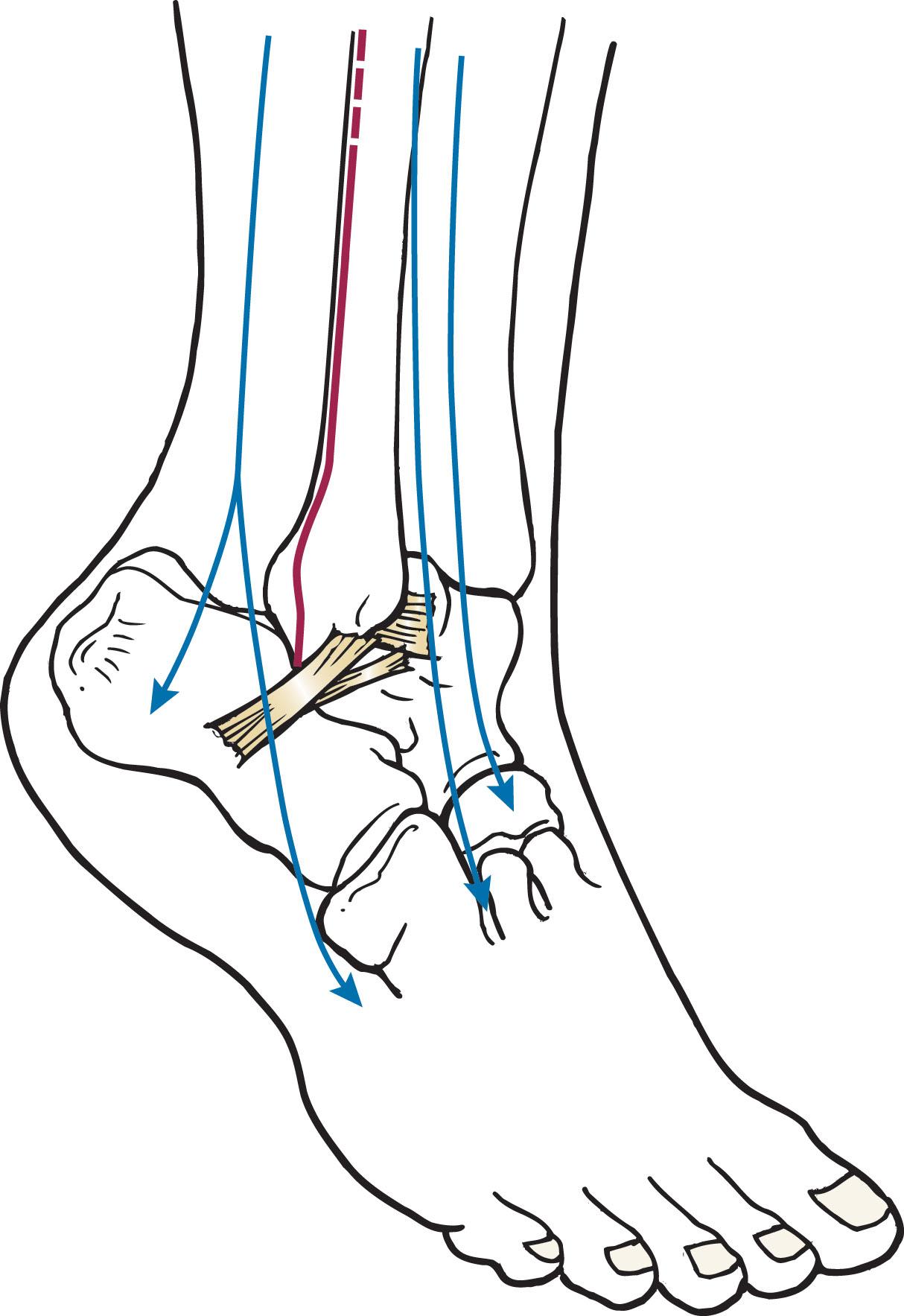
A more posteriorly based incision should be used if a posterior or posterolateral plate is planned for fibular fixation or if access is required to the posterolateral corner of the tibia. This usually requires a larger bump placed under the ipsilateral hip to adequately roll the patient. Care must be taken to protect the sural nerve with a more posterior incision.
The medial approach runs either anterior (this allows an anterior arthrotomy into the ankle) or posterior to the malleolus ( Fig. 44-17 ). The saphenous vein and nerve should be protected during this approach.
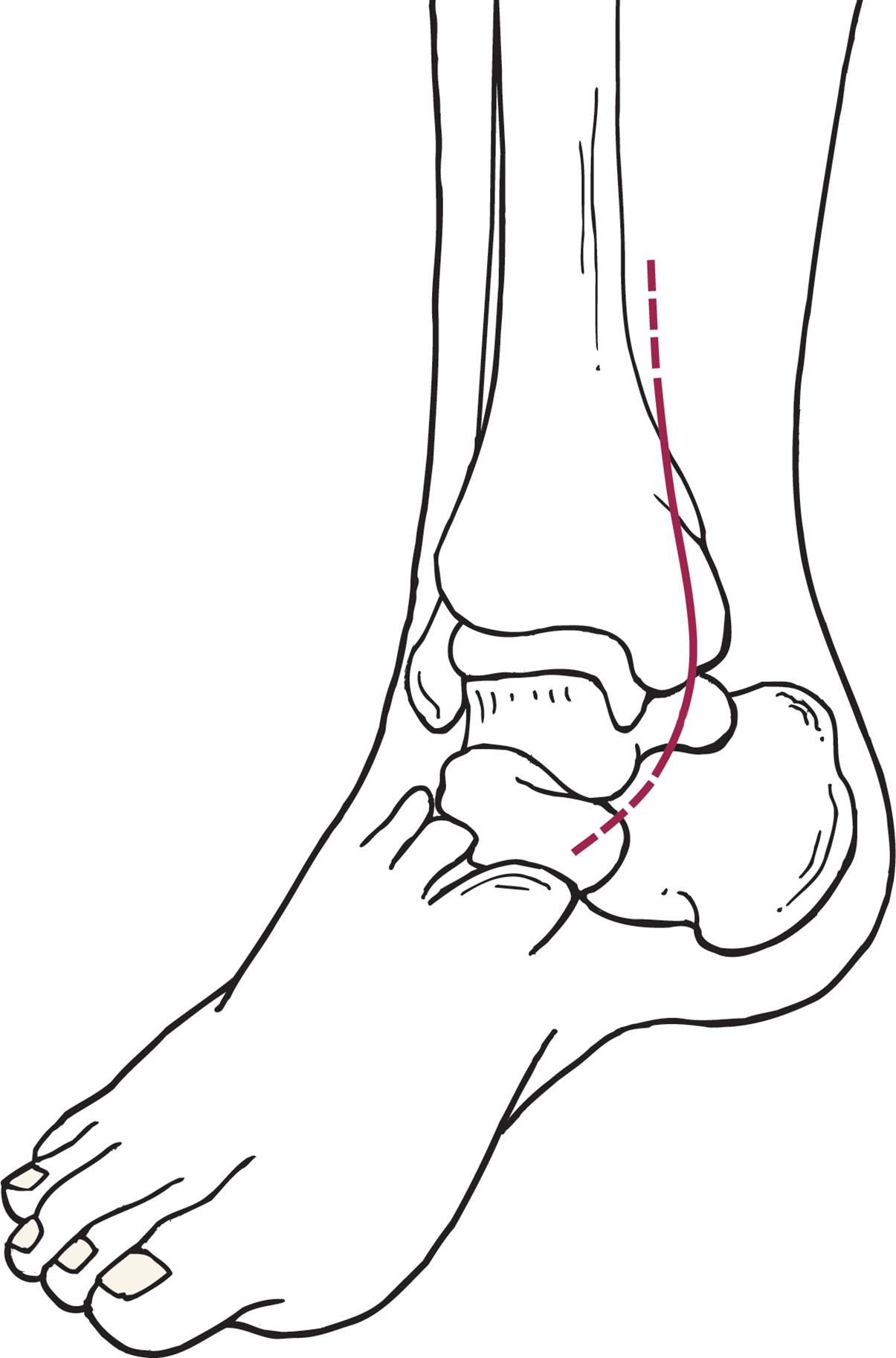
A traditional posterolateral approach can be used between the Achilles tendon and the peroneal tendons. Injury to the sural nerve should be avoided. Dissection is carried through the posterior fat pad to the posterior aspect of the tibia. The flexor hallucis longus (FHL) lies medially and overlies the posterior tibial artery and nerve. The peroneal tendons lie laterally. Both tibia and fibula fractures are accessible through this approach. The posterior tibia is exposed by elevating the origin of the FHL from the posterior fibula and retracting it medially. The fibula can be exposed by retracting the peroneal tendons either medially or laterally ( Fig. 44-18 ).
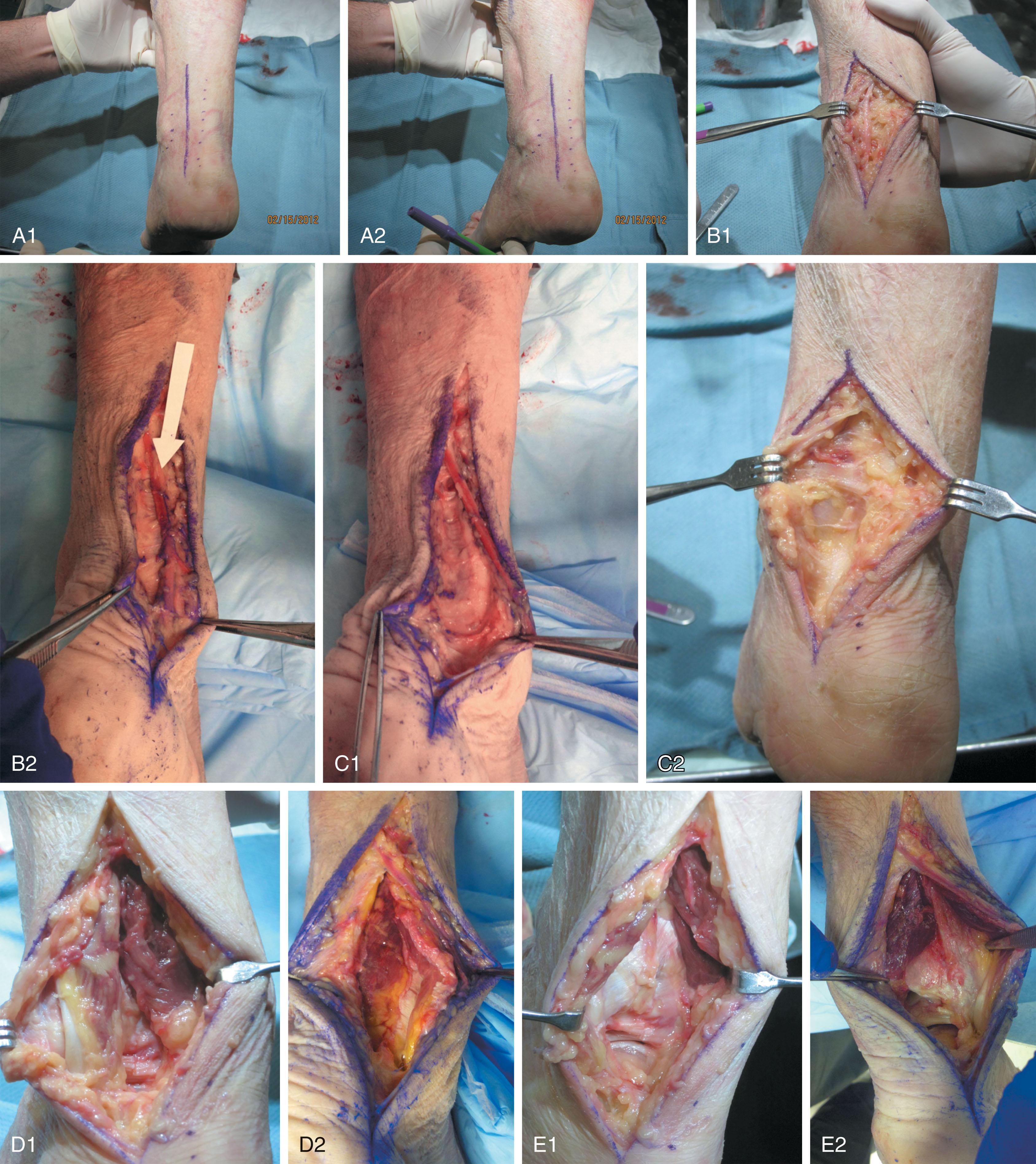
Regardless of which incision is chosen for optimal exposure and fixation, a meticulous closure is important to restore soft tissue anatomy and reduce the risk of wound-healing concerns. A recent randomized controlled trial demonstrated that running subcuticular closure results in superior incision perfusion compared to Allgower-Donati, vertical mattress, horizontal mattress, and simple suture closure.
Become a Clinical Tree membership for Full access and enjoy Unlimited articles
If you are a member. Log in here